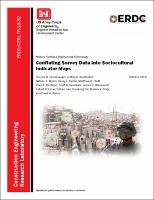Please use this identifier to cite or link to this item:
https://hdl.handle.net/11681/29921Full metadata record
| DC Field | Value | Language |
|---|---|---|
| dc.contributor.author | Ehlschlaeger, Charles R. | - |
| dc.contributor.author | Burkhalter, Jeffrey A. | - |
| dc.contributor.author | Myers, Natalie R. D. | - |
| dc.contributor.author | Baxter, Carey L. | - |
| dc.contributor.author | Hiett, Matthew D. | - |
| dc.contributor.author | Hartman, Ellen R. | - |
| dc.contributor.author | Tweddale, Scott A. (Scott Allen) | - |
| dc.contributor.author | Westervelt, James D. | - |
| dc.contributor.author | Lozar, Robert C. | - |
| dc.contributor.author | Drigo, Marina V. | - |
| dc.contributor.author | Brown, David A. | - |
| dc.contributor.author | Gao, Yizhao | en_US |
| dc.contributor.author | Yin, Dandong | - |
| dc.date.accessioned | 2018-11-01T13:28:05Z | - |
| dc.date.available | 2018-11-01T13:28:05Z | - |
| dc.date.issued | 2018-10 | - |
| dc.identifier.govdoc | ERDC/CERL TR-18-32 | - |
| dc.identifier.uri | http://hdl.handle.net/11681/29921 | - |
| dc.identifier.uri | http://dx.doi.org/10.21079/11681/29921 | - |
| dc.description | Technical Report | - |
| dc.description.abstract | This report presents a methodology of mapping population-centric social, infrastructural, and environmental metrics at neighborhood scale. This methodology extends traditional survey analysis methods to create cartographic products useful in agent-based modeling and geographic information analysis. It utilizes and synthesizes survey microdata, sub-upazila attributes, land-use information, and ground-truth locations of attributes to create neighborhood-scale multi-attribute maps. Monte Carlo methods are used to combine any number of survey responses to stochastically weight survey cases and to simulate survey-case locations in a study area. Through these methods, known errors from each input source can be retained. By keeping the individual survey case as the atomic unit of data representation, this methodology ensures that important covariates are retained and that ecological inference fallacy is eliminated. These techniques are demonstrated using data and output maps for Chittagong Division, Bangladesh. The results provide a population-centric understanding of many social, infrastructural, and environmental metrics desired in humanitarian aid and disaster relief planning and operations wherever long-term familiarity is lacking. Of critical importance is that the resulting products have easy-to-use explicit representation of the errors and uncertainties for each input source via the automatically generated summary statistics created at the application’s geographic scale. | en_US |
| dc.description.sponsorship | United States. Office of the Assistant Secretary of the Army for Acquisition, Logistics, and Technology. | en_US |
| dc.description.sponsorship | Military Facilities Engineering Technology Program (U.S.) | - |
| dc.description.tableofcontents | Abstract .................................................................................................................................... ii Figures and Tables .................................................................................................................. iv Preface ..................................................................................................................................... vi 1 Introduction ...................................................................................................................... 1 1.1 Background ........................................................................................................ 1 1.2 Objective............................................................................................................. 3 1.3 Approach ............................................................................................................ 3 2 Methodology ..................................................................................................................... 4 2.1 Data conflation process .................................................................................... 4 2.2 Six-step survey response mapping process ..................................................... 4 2.3 Definitions .......................................................................................................... 6 3 Input Data ......................................................................................................................... 7 3.1 Population enumeration.................................................................................... 7 3.2 Surveys or microdata ......................................................................................... 8 3.3 Survey case density map .................................................................................. 9 3.4 Survey response constraint maps .................................................................. 10 3.5 Ground truth samples ..................................................................................... 10 4 Processes ........................................................................................................................ 11 4.1 Weighting survey cases to census data .........................................................11 4.2 Spatial allocation and maximum entropy ..................................................... 12 4.3 The shuffle households processes ................................................................. 14 4.4 Kernel density estimation and generating response maps ..........................15 4.4.1 Proportion maps ........................................................................................................ 15 4.4.2 Combining proportion maps into indicator maps .................................................... 16 4.5 Proportion map summary statistics ............................................................... 21 5 Discussion of Example Outputs .................................................................................... 22 5.1 Geolocated survey case maps ....................................................................... 22 5.2 Survey response mapping (indicator maps) ................................................. 23 5.3 Conclusion ....................................................................................................... 31 6 Summary ......................................................................................................................... 32 References ............................................................................................................................. 34 Report Documentation Page | - |
| dc.format.extent | 44 pages / 3.02 Mb | - |
| dc.format.medium | PDF/A | - |
| dc.language.iso | en_US | en_US |
| dc.publisher | Construction Engineering Research Laboratory (U.S.) | en_US |
| dc.publisher | Engineer Research and Development Center (U.S.) | en_US |
| dc.relation.ispartofseries | Technical Report (Engineer Research and Development Center (U.S.)) ; no. ERDC/CERL TR-18-32 | - |
| dc.rights | Approved for Public Release; Distribution is Unlimited | - |
| dc.source | This Digital Resource was created in Microsoft Word and Adobe Acrobat | - |
| dc.subject | Sociology, Military | en_US |
| dc.subject | Cities and towns | en_US |
| dc.subject | Bangladesh | en_US |
| dc.subject | Geographic information systems | en_US |
| dc.subject | Demographic surveys | en_US |
| dc.title | Conflating survey data into sociocultural indicator maps | en_US |
| dc.type | Report | en_US |
| Appears in Collections: | Technical Report | |
Files in This Item:
| File | Description | Size | Format | |
|---|---|---|---|---|
| ERDC-CERL TR-18-32.pdf | 3.09 MB | Adobe PDF |  View/Open |